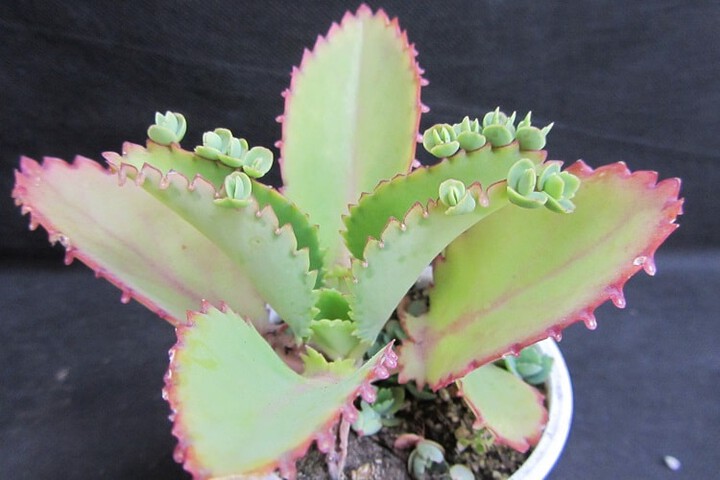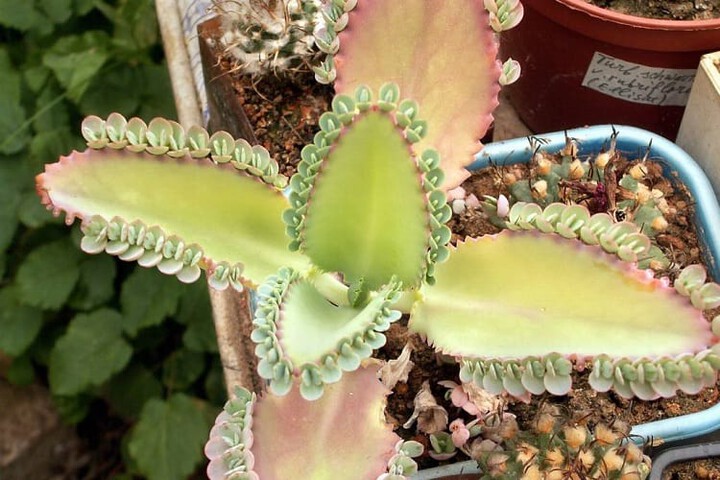If you want to leave your Mother of Thousands to shed its plantlets and watch where they take up root in your garden, that’s great.
However, you might want to have more control over the process of growing these fascinating plants. If so, you should follow these steps to grow your own Mother of Thousands.
What You’ll Need:
Plantlets (taken from your Mother of Thousands plant)
Pot
Soil mix
Plastic wrap
Instructions:
Remove some of the plantlets from the leaves of your Mother of Thousands succulent.
In a pot, pour some commercial cactus mix soil.
Place the plantlets on the surface of the soil, then cover the pot with plastic wrap.
Make sure you leave the pot in a sunny place.
You should keep the soil moist. Do not overwater it.
When the plantlets start to grow and can reach the plastic wrap, remove the plastic. You should now plant them in a larger plant so that they can grow more comfortably.
Always handle the plant’s roots carefully as they can be easily injured. A good tip when transplanting your Mother of Thousands is to make a large hole in the soil so that you don’t get too close to the roots.
Should You Prune Your Mother Of Thousands Succulent?
If you’ve planted your Mother of Thousands outside, it can grow up to three feet tall. When left to its own devices, this plant can easily get out of control so it’s a good idea to prune it.
All you need to do is pinch off the top of the plant at a height that you prefer it to remain. This will force the plant to produce offshoots from its sides.
You should also snip off any dead leaves on your plant. While not essential, this will give the plant a healthier and more attractive appearance.
5 Interesting Types Of Mother Of Thousands Succulents

There are many different types of Mother of Thousands plants. Here are some of the most interesting types, but first we need to understand Bryophyllum plants as you’ve probably heard this name when Mother of Thousands is mentioned.
Bryophyllum is a group of plants in the Crassulaceae family, which is part of the Kalanchoe genus but is sometimes also thought to have its own class.
Like the Kalanchoe, the Bryophyllum has plantlets along its leaves’ edges and these can drop off to create new plants.
One of the biggest differences between Kalanchoe and Bryophyllum is that the flowers of the Bryophyllum are in a pendant design while the flowers that sometimes bloom on the Kalanchoe remain upright.
However, to make matters confusing, their names are sometimes used interchangeably. For instance, some of the plants listed below can be called Kalanchoe or Bryophyllum plants.
Mother of Thousands is scientifically known as Kalanchoe daigremontiana, but can also be called Bryophyllum daigremontianum!
Let’s look at some of the most fascinating bryophyllum and kalanchoe plants.
Bryophyllum Pinnatum
This is a fleshy plant that can grow to heights of between 23 and 47 inches. It has broad leaves that give rise to small plantlets, and they have pretty scalloped margins.
The Pinnatum has bell-shaped flowers that can be yellow, pink, or red, and they appear in clusters at the top of the plant’s stems.
Kalanchoe Laetivirens
This plant is sometimes called “Big Momma” because it is such a prolific plant. It blooms in red and pink flowers, and you can see these appear above the plant’s leaves during early spring.
This plant is considered to be quite unusual because it has blue and green plantlets that appear along the edges of its leaves. It can grow up to eight inches in length and three inches wide.
Kalanchoe Tubiflora
This succulent has narrow leaves that are gray and green in color and also have burgundy spots on them. You’ll find baby plantlets appear on the tips of the succulent’s leaves before they drop off onto the ground.
Kalanchoe Tubiflora is known as the “chandelier plant” because of how its leaves stick out from its stem, and it can grow up to four feet in height!
Kalanchoe Marnieriana
This succulent has blue-green leaves that are flat and round, so that they look a bit like clam shells. Sometimes the edges of the leaves can turn red.
They have flowering stalks that appear from their center and bloom in beautiful pink and red flowers. This succulent plant can grow up to two feet in height.
Kalanchoe Fedtschenkoi
This plant, which is sometimes called “Lavender Scallops,” has fleshy blue-green leaves and scalloped edges that are tinged in lavender, which makes it very striking.
The leaves tend to form in bunches, which makes it an excellent plant to use as ground cover.
During the spring and summer, this succulent displays reddish-brown bell-shaped flowers that appear in clusters. The plant can grow between one to two feet in height.
Related Questions

What Causes The Leaves Of Mother Of Thousands To Curl?
This can happen for two reasons: either you’re not giving your plant enough sun or you’re giving it too much water. By fixing those problems, you’ll be able to stop its leaves from curling.
Is Mother Of Thousands Prone To Disease?
It’s actually quite disease-resistant, but you might find it gets aphids. You should remove them by washing them off the plant.
Is Mother Of Thousands Poisonous?
Yes, all parts of the plant are considered toxic, so be sure to keep it away from pets and children, especially if you grow the plant indoors. When ingested, this plant can cause side effects such as vomiting, heart palpitations, and diarrhea.
Conclusion
Mother of Thousands is an intriguing plant that every succulent lover will want to grow. But there’s not just one type of Mother of Thousands.
In this article, we’ve looked at the different Mother of Thousands varieties, as well as provided you with everything you need to know to grow your own Mother of Thousands.
It’s not just beautiful but sure to give your home or garden an unusual touch!